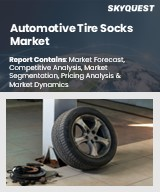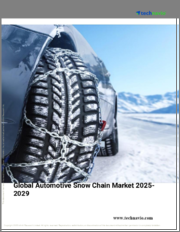
|
시장보고서
상품코드
1639206
자동차 스노우 체인 시장 기회, 성장 촉진요인, 산업 동향 분석, 예측(2025-2034년)Automotive Snow Chain Market Opportunity, Growth Drivers, Industry Trend Analysis, and Forecast 2025 to 2034 |
||||||
자동차 스노우 체인 세계 시장은 2024년에는 4억 6,340만 달러로 평가되었고, 2025년부터 2034년에 걸쳐 CAGR 5.3%를 나타낼 것으로 예측됩니다.
동계 관광과 스포츠에 대한 관심 증가가 주요 성장 요인이며, 강설량이 많은 지역에서는 스노우 체인 수요가 높아지고 있습니다. 여행자는 특히 겨울 활동으로 알려진 목적지에서 얼어 붙은 도로를 안전하게 여행하기 위해 스노우 체인을 사용합니다. 게다가 눈이 내리기 쉬운 지역에서의 자동차 보유 대수 증가도 시장 확대에 기여하고 있으며, 많은 자동차 소유자가 가혹한 겨울에도 안전을 확보하기 위해 스노우 체인을 채용하고 있습니다.
스노우 체인은 지역 및 교외와 같은 제설 서비스의 빈도가 낮은 지역에서는 필수적입니다. 유럽, 북미, 아시아의 일부 국가에서는 가혹한 겨울 상황과 눈길에서 견고한 트랙션이 필요하기 때문에 수요가 증가하고 있습니다.
시장은 제품별로 비금속 체인(폴리우레탄제), 금속 체인, 직물 체인, 자동 체인으로 분류됩니다. 금속 체인은 2024년에 40%의 점유율을 차지하며, 2034년에는 3억 달러에 이를 것으로 예상됩니다. 내구성과 뛰어난 그립력으로 유명한 금속 체인은 동결된 험한 지형에서의 성능으로 선호됩니다. 탄력성이 있기 때문에 가혹한 조건에서 주행하는 대형 차량에 이상적입니다.
| 시장 범위 | |
|---|---|
| 시작연도 | 2024 |
| 예측연도 | 2025-2034 |
| 시작금액 | 4억 6,340만 달러 |
| 예측 금액 | 7억 1,870만 달러 |
| CAGR | 5.3% |
차량별로는 승용차, 상용차, 이륜차로 구분됩니다. 승용차의 2024년 점유율은 67%이며, 이는 개인 소유의 자동차가 세계적으로 많은 것이 요인입니다. 개인 소유자에 의한 스노우 체인의 보급에 의해 가혹한 겨울의 날씨 하에서도 트랙션이 강화되어 안전성이 확보됩니다. 동계의 특정 도로에서 스노우 체인 사용을 의무화하는 규제 조치가이 부문의 성장을 더욱 강화하고 있습니다. 설치가 쉽고 가격도 저렴하기 때문에 스노우 체인은 승용차에 실용적인 솔루션입니다.
지역별로는 유럽이 시장을 독점하고, 2024년에는 45%를 차지하고, 2034년에는 3억 5,000만 달러에 이를 것으로 예상되고 있습니다. 동지역의 성장의 원동력이 되고 있는 것은 동계의 엄격한 교통 안전 규제와 높은 자동차 보유율입니다. 독일은 유럽 시장을 선도하고 2034년까지 1억 달러를 창출합니다. 고산지대의 강설량이 많은 것, 자동차산업과 애프터마켓산업이 확립하고 있는 것이 그 요인입니다.
다양한 차종과 지역에서 스노우 체인의 채용이 증가하고 있기 때문에 가혹한 겨울 상황에서 교통 안전을 확보하고 차량의 성능을 높이는 데 스노우 체인의 중요성이 부각되고 있습니다.
목차
제1장 조사 방법과 조사 범위
제2장 주요 요약
제3장 업계 인사이트
- 생태계 분석
- 공급자의 상황
- 원재료 공급업체
- 제조업체
- 유통 및 도매업체
- 소매업체
- 최종 사용자
- 이익률 분석
- 각종 스노우 체인의 가격 분석
- 기술 혁신의 상황
- 주요 뉴스와 대처
- 규제 상황
- 영향요인
- 성장 촉진요인
- 호설지대에서의 겨울 스포츠와 관광의 인기 상승
- 겨울의 교통 안전에 관한 정부의 규제 강화
- 적설이 많은 지역에서 자동차 보유 대수 증가
- 스노체인 소재와 자동 설치 시스템의 기술 진보
- 업계의 잠재적 위험 및 과제
- 사용기간의 제한
- 복잡한 설치 프로세스
- 성장 촉진요인
- 성장 가능성 분석
- Porter's Five Forces 분석
- PESTEL 분석
제4장 경쟁 구도
- 소개
- 기업 점유율 분석
- 경쟁 포지셔닝 매트릭스
- 전략 전망 매트릭스
제5장 시장 추정 및 예측 : 제품별, 2021년-2034년
- 주요 동향
- 금속
- 비금속(폴리우레탄)
- 직물
- 자동 체인
제6장 시장 추정 및 예측 : 체인별, 2021년-2034년
- 주요 동향
- 스터드식 스노체인
- 비스터드식 스노체인
- 케이블 스노체인
- 래더 스노체인
제7장 시장 추정 및 예측 : 차량별, 2021년-2034년
- 주요 동향
- 승용차
- 해치백
- 세단
- SUV
- 상용차
- 소형 상용차(LCV)
- 대형 상용차(HCV)
- 이륜차
제8장 시장 규모 추정 및 예측 : 사이즈별, 2021년-2034년
- 주요 동향
- 소형(15인치까지)
- 중형(15-18인치)
- 대형(18인치 이상)
제9장 시장 추정 및 예측 : 최종 용도별, 2021년-2034년
- 주요 동향
- 개인 사용
- 상업 사용
제10장 시장 추정 및 예측 : 유통 채널별, 2021년-2034년
- 주요 동향
- 온라인
- 오프라인
제11장 지역별 시장 추정 및 예측 : 지역별, 2021년-2034년
- 주요 동향
- 북미
- 미국
- 캐나다
- 유럽
- 영국
- 독일
- 프랑스
- 스페인
- 이탈리아
- 러시아
- 북유럽
- 아시아태평양
- 중국
- 인도
- 일본
- 한국
- 뉴질랜드
- 동남아시아
- 라틴아메리카
- 브라질
- 멕시코
- 아르헨티나
- 중동 및 아프리카
- UAE
- 남아프리카
- 사우디아라비아
제12장 기업 프로파일
- Cobra Chains
- EAS-SNOW CHAINS
- Felice Sacchi
- Konig Chains
- Konig SpA
- Laclede Chain Manufacturing Company LLC
- Lex Products Corporation
- Maggi Group
- Michelin
- Ottinger GmbH
- Peerless Industrial Group
- Pewag Group
- Quality Chain Corporation
- Rud Ketten Rieger & Dietz GmbH
- Security Chain Company
- Snow Chain Systems
- Thule Group
- Trygg Nosted Kjetting AS
- Veriga KF
- Weissenfels
The Global Automotive Snow Chain Market was valued at USD 463.4 million in 2024 and is projected to grow at a CAGR of 5.3% between 2025 and 2034. Increasing interest in winter tourism and sports is a primary growth driver, as regions with heavy snowfall experience heightened demand for snow chains. Travelers rely on these chains for safe navigation on icy roads, especially in destinations known for winter activities. Additionally, growing vehicle ownership in snow-prone areas contributes to market expansion, with many vehicle owners adopting snow chains to ensure safety during harsh winters.
Snow chains are vital in regions with infrequent snow removal services, such as rural and suburban areas. Countries across Europe, North America, and parts of Asia are experiencing an uptick in demand due to harsh winter conditions and the necessity of reliable traction on snowy roads.
The market is categorized by product into non-metallic (polyurethane), metallic, fabric, and automatic chains. Metallic chains held a 40% share in 2024 and are expected to reach USD 300 million by 2034. Known for their durability and superior grip, metallic chains are preferred for their performance on icy and rugged terrains. Their resilience makes them ideal for heavy-duty vehicles operating in extreme conditions.
| Market Scope | |
|---|---|
| Start Year | 2024 |
| Forecast Year | 2025-2034 |
| Start Value | $463.4 Million |
| Forecast Value | $718.7 Million |
| CAGR | 5.3% |
In terms of vehicle type, the market is segmented into passenger cars, commercial vehicles, and motorcycles. Passenger cars represented a 67% share in 2024, driven by the vast global fleet of personal vehicles. The widespread use of snow chains by individual car owners ensures enhanced traction and safety during severe winter weather. Regulatory measures mandating snow chain use on specific roads during winter have further bolstered segment growth. Ease of installation and affordability also make snow chains a practical solution for passenger vehicles.
Regionally, Europe dominated the market, accounting for 45% in 2024 and expected to reach USD 350 million by 2034. The region's growth is fueled by strict winter road safety regulations and high vehicle ownership. Germany leads the European market, generating USD 100 million by 2034, driven by significant snowfall in alpine areas and well-established automotive and aftermarket industries.
The rising adoption of snow chains across various vehicle types and regions underscores their importance in ensuring road safety and enhancing vehicle performance in challenging winter conditions.
Table of Contents
Chapter 1 Methodology & Scope
- 1.1 Research design
- 1.1.1 Research approach
- 1.1.2 Data collection methods
- 1.2 Base estimates and calculations
- 1.2.1 Base year calculation
- 1.2.2 Key trends for market estimates
- 1.3 Forecast model
- 1.4 Primary research & validation
- 1.4.1 Primary sources
- 1.4.2 Data mining sources
- 1.5 Market definitions
Chapter 2 Executive Summary
- 2.1 Industry 360° synopsis, 2021 - 2034
Chapter 3 Industry Insights
- 3.1 Industry ecosystem analysis
- 3.2 Supplier landscape
- 3.2.1 Raw material suppliers
- 3.2.2 Manufacturers
- 3.2.3 Distributors and wholesalers
- 3.2.4 Retailers
- 3.2.5 End users
- 3.3 Profit margin analysis
- 3.4 Price analysis of different snow chains
- 3.5 Technology & innovation landscape
- 3.6 Key news & initiatives
- 3.7 Regulatory landscape
- 3.8 Impact forces
- 3.8.1 Growth drivers
- 3.8.1.1 Rising popularity of winter sports and tourism in regions with heavy snowfall
- 3.8.1.2 Stricter government regulations regarding winter road safety
- 3.8.1.3 Rising vehicle ownership in snow-prone regions
- 3.8.1.4 Technological advancements in snow chain materials and automatic installation systems
- 3.8.2 Industry pitfalls & challenges
- 3.8.2.1 Limited usage period
- 3.8.2.2 Complex installation process
- 3.8.1 Growth drivers
- 3.9 Growth potential analysis
- 3.10 Porter's analysis
- 3.11 PESTEL analysis
Chapter 4 Competitive Landscape, 2024
- 4.1 Introduction
- 4.2 Company market share analysis
- 4.3 Competitive positioning matrix
- 4.4 Strategic outlook matrix
Chapter 5 Market Estimates & Forecast, By Product, 2021 - 2034 ($Bn, Units)
- 5.1 Key trends
- 5.2 Metallic
- 5.3 Non-Metallic (Polyurethane)
- 5.4 Fabric
- 5.5 Automatic chains
Chapter 6 Market Estimates & Forecast, By Chain, 2021 - 2034 ($Bn, Units)
- 6.1 Key trends
- 6.2 Studded snow chains
- 6.3 Non-studded snow chains
- 6.4 Cable snow chains
- 6.5 Ladder snow chains
Chapter 7 Market Estimates & Forecast, By Vehicle, 2021 - 2034 ($Bn, Units)
- 7.1 Key trends
- 7.2 Passenger cars
- 7.2.1 Hatchback
- 7.2.2 Sedan
- 7.2.3 SUV
- 7.3 Commercial vehicles
- 7.3.1 Light Commercial Vehicles (LCV)
- 7.3.2 Heavy Commercial Vehicles (HCV)
- 7.4 Motorcycles
Chapter 8 Market Estimates & Forecast, By Size, 2021 - 2034 ($Bn, Units)
- 8.1 Key trends
- 8.2 Small (up to 15 inches)
- 8.3 Medium (15-18 inches)
- 8.4 Large (over 18 inches)
Chapter 9 Market Estimates & Forecast, By End Use, 2021 - 2034 ($Bn, Units)
- 9.1 Key trends
- 9.2 Personal use
- 9.3 Commercial use
Chapter 10 Market Estimates & Forecast, By Distribution Channel, 2021 - 2034 ($Bn, Units)
- 10.1 Key trends
- 10.2 Online
- 10.3 Offline
Chapter 11 Market Estimates & Forecast, By Region, 2021 - 2034 ($Bn, Units)
- 11.1 Key trends
- 11.2 North America
- 11.2.1 U.S.
- 11.2.2 Canada
- 11.3 Europe
- 11.3.1 UK
- 11.3.2 Germany
- 11.3.3 France
- 11.3.4 Spain
- 11.3.5 Italy
- 11.3.6 Russia
- 11.3.7 Nordics
- 11.4 Asia Pacific
- 11.4.1 China
- 11.4.2 India
- 11.4.3 Japan
- 11.4.4 South Korea
- 11.4.5 ANZ
- 11.4.6 Southeast Asia
- 11.5 Latin America
- 11.5.1 Brazil
- 11.5.2 Mexico
- 11.5.3 Argentina
- 11.6 MEA
- 11.6.1 UAE
- 11.6.2 South Africa
- 11.6.3 Saudi Arabia
Chapter 12 Company Profiles
- 12.1 Cobra Chains
- 12.2 EAS-SNOW CHAINS
- 12.3 Felice Sacchi
- 12.4 Konig Chains
- 12.5 Konig SpA
- 12.6 Laclede Chain Manufacturing Company LLC
- 12.7 Lex Products Corporation
- 12.8 Maggi Group
- 12.9 Michelin
- 12.10 Ottinger GmbH
- 12.11 Peerless Industrial Group
- 12.12 Pewag Group
- 12.13 Quality Chain Corporation
- 12.14 Rud Ketten Rieger & Dietz GmbH
- 12.15 Security Chain Company
- 12.16 Snow Chain Systems
- 12.17 Thule Group
- 12.18 Trygg Nosted Kjetting AS
- 12.19 Veriga K.F.
- 12.20 Weissenfels



















